My name is Dr. Sarah Ballantyne. I am the blogger behind the award-winning website www.ThePaleoMom.com, cohost of the top-rated and syndicated The Paleo View podcast, and New York Times Bestselling author of four books: Paleo Principles, The Paleo Approach, The Paleo Approach Cookbook, and The Healing Kitchen. I consider myself a health educator and advocate. My credentials lie in three areas. First, I have a Ph.D. in Medical Biophysics and performed award-winning medical research in the area of innate immunity and inflammation. (You can read more about my academic background here.) Second, I am a wife and mother and face the typical challenges that Paleo families navigate. Third, I have had a longstanding personal battle with weight and disease.
This is my story.
My 120-Pound Journey To Paleo
I did not use a Paleo Diet to lose 120 pounds. Instead, I lost the first 100 pounds following a standard low-carb diet. In fact, I lost those 100 pounds twice. In spite of working so hard to lose weight, depriving myself of foods I craved and getting crazy amounts of exercise, I was not healthy. Even though I looked better on the outside, I was getting sicker and sicker–until I found Paleo. I lost the last 20 pounds following a Paleo Diet; but more importantly, I regained my health and have successfully maintained my weight loss for over five years.
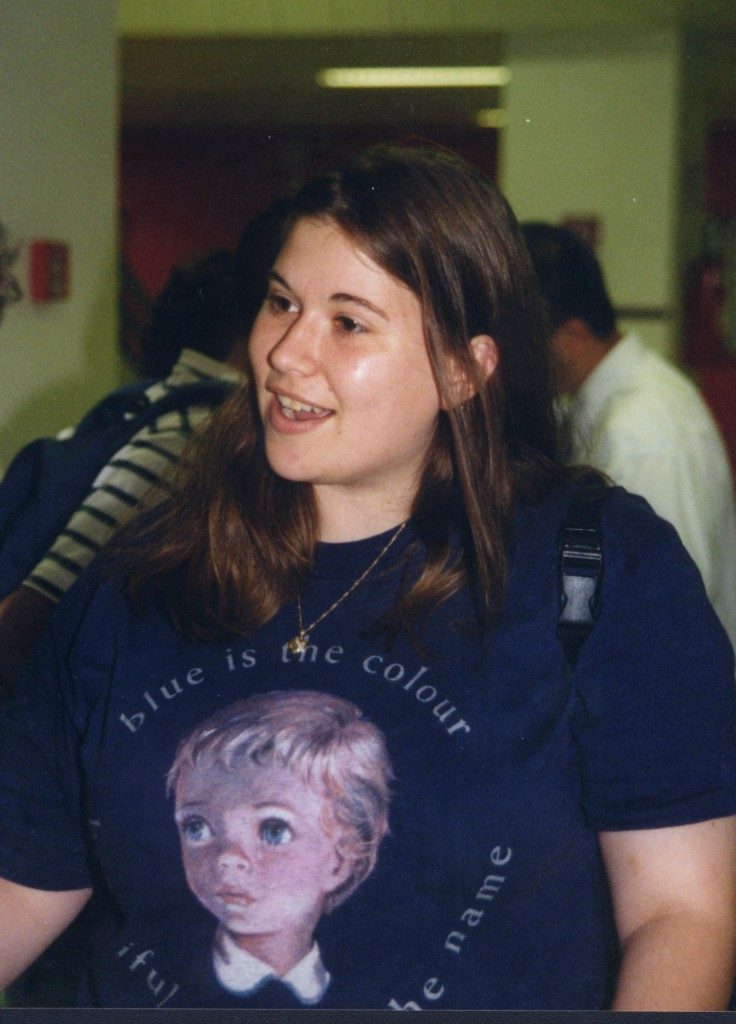 I was teased for being chubby in elementary school, although I was just a sturdily built, tall child. It wasn’t until early middle school that I really started gaining weight. I thought it was my fault, but the math just didn’t add up. I was highly active, walking a mile and a half to and from the school bus stop each day, riding my bike around the neighborhood in the evenings and for hours on the weekends, going for frequent family walks and hikes, and taking swimming lessons. My diet growing up may not have been gluten-free or Paleo, but my mom believed in butter, our dairy was grass-fed, our eggs came from a local farm, and we ate almost entirely whole unprocessed foods, including fish we caught ourselves fresh from the ocean, wild edibles, and vegetables we grew in our garden. I thought that the reason why I was gaining weight, when the other kids around me weren’t, was because of the occasional ice cream sandwich purchased from the school canteen. I thought it was because if I found a quarter on the ground, I’d use it to buy gummy bears from the 5-cent bin at the corner store on my way home. While I didn’t get definitely diagnosed until decades later, these were the first symptoms of Hashimoto’s thyroiditis. I had other symptoms too: chronic fatigue (I would fall asleep on the bus two and from school and in the car no matter how short the drive, willingly went to bed at 8:30pm even in high school, and routinely slept 15-16 hours on weekends), dry skin, brittle nails, thin hair, headaches, mild depression (although, keep in mind I was a teenager, and not a popular one), and a digestive system that at best could be described as sluggish.
I was teased for being chubby in elementary school, although I was just a sturdily built, tall child. It wasn’t until early middle school that I really started gaining weight. I thought it was my fault, but the math just didn’t add up. I was highly active, walking a mile and a half to and from the school bus stop each day, riding my bike around the neighborhood in the evenings and for hours on the weekends, going for frequent family walks and hikes, and taking swimming lessons. My diet growing up may not have been gluten-free or Paleo, but my mom believed in butter, our dairy was grass-fed, our eggs came from a local farm, and we ate almost entirely whole unprocessed foods, including fish we caught ourselves fresh from the ocean, wild edibles, and vegetables we grew in our garden. I thought that the reason why I was gaining weight, when the other kids around me weren’t, was because of the occasional ice cream sandwich purchased from the school canteen. I thought it was because if I found a quarter on the ground, I’d use it to buy gummy bears from the 5-cent bin at the corner store on my way home. While I didn’t get definitely diagnosed until decades later, these were the first symptoms of Hashimoto’s thyroiditis. I had other symptoms too: chronic fatigue (I would fall asleep on the bus two and from school and in the car no matter how short the drive, willingly went to bed at 8:30pm even in high school, and routinely slept 15-16 hours on weekends), dry skin, brittle nails, thin hair, headaches, mild depression (although, keep in mind I was a teenager, and not a popular one), and a digestive system that at best could be described as sluggish.
It was my attempts to lose weight by following the conventional diet wisdom of the late-eighties (low-fat, high-carb, calorie-restricted) that really did me in. I constantly felt deprived while my weight yo-yo’ed more up than down. Overall, I gained 10-30 pounds per year throughout my entire teen years, until I reached morbid obesity status in my early twenties at 265lbs (I’m a little shy of 5’6”). And, I was miserable. I had to hold my breath to tie my shoes. Everything hurt most of the time. I remember feeling so left out when my friends would go for group runs together (and not even bother to ask me). I remember getting an enormous bruise on my behind just by trying to maneuver out of the backseat of a jeep when someone was nice enough to give me a ride.
Obesity wasn’t my only health issue. Psoriasis and eczema started in my mid-teens. By the time I turned twenty, I suffered frequent migraines and, for two years I stopped drinking coffee due to suspected gall bladder issues. I got frequent colds, especially during exam week. I had fairly severe acne (although not bad enough for my doctor to recommend Accutane). I suffered chronic constipation and was tired all the time.
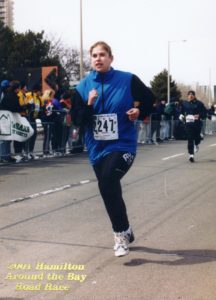 I was first introduced to the concept of low-carb diets in the summer of 1999, when I was 22 years old. It worked very well for me, and over the course of about a year, I lost 100 pounds. Celebrating my newfound waistline, I became very active, taking up marathon running, which entailed 14-16 hour of training runs every week, and karate. Although I always wanted to lose 30 more pounds, I believed that I was healthy. Yet, I was evaluating my health using solely my weight and activity level as the metric.
I was first introduced to the concept of low-carb diets in the summer of 1999, when I was 22 years old. It worked very well for me, and over the course of about a year, I lost 100 pounds. Celebrating my newfound waistline, I became very active, taking up marathon running, which entailed 14-16 hour of training runs every week, and karate. Although I always wanted to lose 30 more pounds, I believed that I was healthy. Yet, I was evaluating my health using solely my weight and activity level as the metric.
I continued to developed more and more health conditions, which at the time seemed unrelated to each other. By the age of 25, I suffered from Irritable Bowel Syndrome (IBS), acid reflux, frequent migraines, anxiety and mild depression, allergies, eczema, scalp psoriasis, chronic colds and strep throats, and I started to suffer an autoimmune skin condition called Lichen Planus. At the time, I blamed the stress of graduate school and my weak genetics. I used to joke that the only reason that I was alive was because of the miracles of modern medicine. Little did I understand at the time that it was the detrimental effects of my modern diet (combined with high stress, excessive exercise, and a genetic susceptibility) causing a cascade of ever increasing inflammation, hormone dysregulation, and autoimmunity.
I had a major health crisis in the summer of 2002. Adult onset of severe asthma robbed me of my active lifestyle. My lungs became extremely reactive and the inflammation was so severe that I was coughing up blood. Practically overnight, I became apartment bound, was put on extremely high doses of inhaled and oral steroids, and my entire world came crashing down. Uncontrolled weight gain is a side effect of those oral steroids and I gained 50 pounds in the first 6 weeks on them. I ended up suffering severe depression and reverting to bad eating habits (lots of sugar and binge-eating habits). I gained the other 50 pounds (that I had worked so hard to lose) more slowly over the next year. I got married in that year and weighed 235 pounds at my wedding, which was absolutely crushing for my spirit.
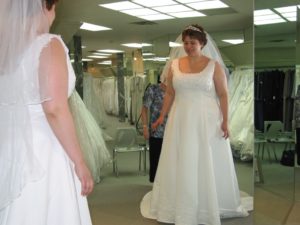 I was in so much denial about my weight that I put off shopping for a wedding dress until 2 weeks before the wedding. My wedding dress was a size 26 (to be fair, I think I was only wearing plus-size 18-20 at the time). I think this photo is far more interesting than photos from my actual wedding because of my facial expression. That is the dress I ended up buying–it was very flattering. But, on my face you can see the conflict, how heart-breaking it was to have been so much thinner only months before and to be looking in the mirror at an obese woman. Our wedding was beautiful; but, I have kept my dress in the hopes of someday having it completely remade for a smaller me to renew our vows.
I was in so much denial about my weight that I put off shopping for a wedding dress until 2 weeks before the wedding. My wedding dress was a size 26 (to be fair, I think I was only wearing plus-size 18-20 at the time). I think this photo is far more interesting than photos from my actual wedding because of my facial expression. That is the dress I ended up buying–it was very flattering. But, on my face you can see the conflict, how heart-breaking it was to have been so much thinner only months before and to be looking in the mirror at an obese woman. Our wedding was beautiful; but, I have kept my dress in the hopes of someday having it completely remade for a smaller me to renew our vows.
I was cycling between low-carb and out-of-control binges, occasionally going on ketogenic whey protein + flax oil fasts. Nothing worked, nothing was sustainable, and I was miserable. I was defeated and gave up trying.
Twice during my 20s, I had low thyroid hormone levels show up on blood work. But, because my TSH (thyroid stimulating hormone) level remained normal, no further testing or follow-up was ever pursued. I think it’s likely that many of my conditions were secondary to Hashimoto’s thyroiditis (diagnosed years later) and that this health crisis was rooted in an autoimmune flare.
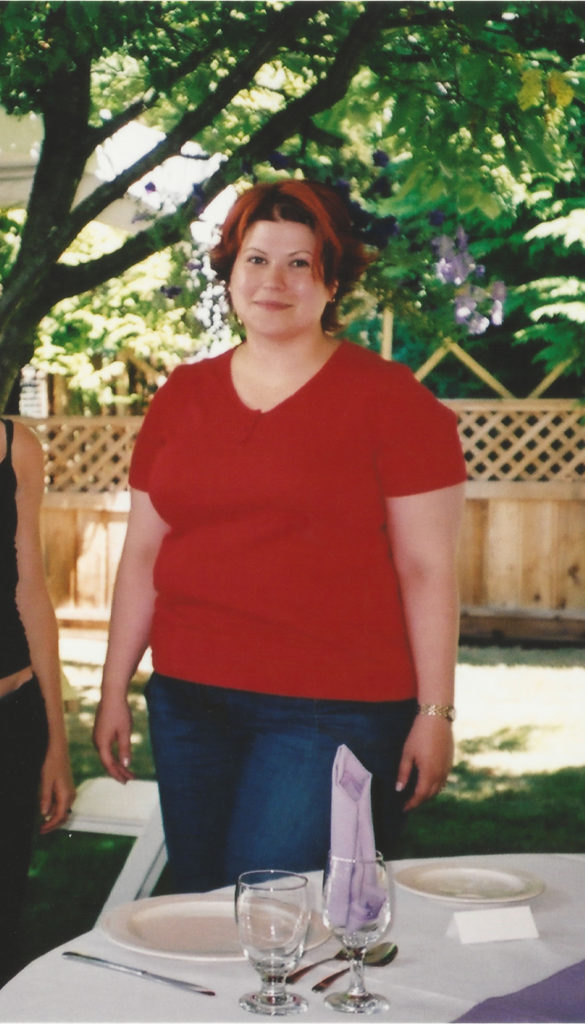 I continued to gain weight, hitting my heaviest at age 28. At this point, I was a postdoctoral fellow in a very high-profile research lab in Toronto, Ontario, doing ground-breaking medical research and working 80-100 hour weeks. I stopped weighing myself after 265 pounds and assume that I gained 15-25 more pounds after that based on the fact that I went up two entire clothing sizes. I think I was pushing 300 pounds at my biggest, but will never know for sure. I was wearing plus-size 26 clothes. I was very unhappy. I dyed my hair crazy colors to compensate for low self-esteem. I started avoiding cameras and there are very few photos of me for a 5-year period. I had migraines, IBS, acid reflux, chronic colds, asthma, allergies, lichen planus, eczema, anxiety, depression, carpel tunnel syndrome, early arthritis, stenosing tenosynovitis, borderline high blood pressure, borderline high triglycerides, and borderline high insulin levels. I had developed binge-eating disorder.
I continued to gain weight, hitting my heaviest at age 28. At this point, I was a postdoctoral fellow in a very high-profile research lab in Toronto, Ontario, doing ground-breaking medical research and working 80-100 hour weeks. I stopped weighing myself after 265 pounds and assume that I gained 15-25 more pounds after that based on the fact that I went up two entire clothing sizes. I think I was pushing 300 pounds at my biggest, but will never know for sure. I was wearing plus-size 26 clothes. I was very unhappy. I dyed my hair crazy colors to compensate for low self-esteem. I started avoiding cameras and there are very few photos of me for a 5-year period. I had migraines, IBS, acid reflux, chronic colds, asthma, allergies, lichen planus, eczema, anxiety, depression, carpel tunnel syndrome, early arthritis, stenosing tenosynovitis, borderline high blood pressure, borderline high triglycerides, and borderline high insulin levels. I had developed binge-eating disorder.
I lost some weight when we first moved to America in 2005, when I was 29 years old. The slower pace of my second postdoctoral fellowship was very restorative. I was down to 255 pounds when I got pregnant with our first daughter. I had gestational diabetes during the pregnancy. Between the diet limitations forced upon me and the pregnancy-induced changes to my appetite, I lost 2 pounds overall during my pregnancy. Even still, it wasn’t until I was about 7.5 months pregnant that you could really tell without a doubt that I was actually pregnant and not just overweight. My daughter’s birth was long (labor was 97-hours) and complicated. We avoided an emergency C-section by minutes (and only because we had an amazing midwife). After our daughter was born, I was too exhausted to do much other than survive (oh the colic!), but I did keep my weight steady around 230 pounds. And other than a few new allergies, my laundry list of diagnosed health conditions stayed stable. I took six different prescription medications on a regular basis in addition to many non-prescription medications and supplements.
 Shortly after my daughter’s first birthday in early 2008 (when I was 31 years old), I noticed a familiar feeling of dizziness after eating. I still had my glucometer and testing supplies leftover from managing gestational diabetes. So, I tested my blood sugar. It was 200, high enough to qualify me as pre-diabetic and on the cusp of type 2 diabetes. I never went to a doctor about it because I was too embarrassed. Fear now motivated me to follow a strict low-darb diet and I was again successful at losing weight. Over a year, I got back down to 165 pounds, which is when I got pregnant with my second daughter. I had a much healthier pregnancy, with no gestational diabetes and no blood pressure issues even though I gained 60 pounds during this pregnancy, although I did develop some pretty dramatic varicose veins. I also had a much easier labor and delivery (yes, I do call 20 hours with pitocin and no drugs easier).
Shortly after my daughter’s first birthday in early 2008 (when I was 31 years old), I noticed a familiar feeling of dizziness after eating. I still had my glucometer and testing supplies leftover from managing gestational diabetes. So, I tested my blood sugar. It was 200, high enough to qualify me as pre-diabetic and on the cusp of type 2 diabetes. I never went to a doctor about it because I was too embarrassed. Fear now motivated me to follow a strict low-darb diet and I was again successful at losing weight. Over a year, I got back down to 165 pounds, which is when I got pregnant with my second daughter. I had a much healthier pregnancy, with no gestational diabetes and no blood pressure issues even though I gained 60 pounds during this pregnancy, although I did develop some pretty dramatic varicose veins. I also had a much easier labor and delivery (yes, I do call 20 hours with pitocin and no drugs easier).
Neither of my daughters were sleepers (for different physiological reasons which you can learn more about here, and not a reflection of my parenting style). I struggled to lose weight after my second daughter was born, but did manage to eventually lose most of the pregnancy weight by again reverting to my low-carb ways. I was lighter, my blood pressure and cardiovascular risk factors were normal and the prediabetes was gone; but I was still plagued with IBS, acid reflux, migraines, stress and anxiety, asthma, allergies, eczema, psoriasis, lichen planus, chronic colds, daily joint pain, and low energy. In fact, by every other metric not related to metabolic syndrome, by health was deteriorating.
There was nothing special about the day my approach to health changed. My youngest daughter was 1.5 years old and I was sitting in her bedroom watching her play. It was summer, 90F outside, and I was wearing pants and long sleeves because eczema and lichen planus lesions were so bad on my arms and legs. Having skin conditions felt similar to being obese for me, like I was wearing a visible badge for everyone to see that screamed “I’m not healthy”. I had a headache, my joints were sore, and I had been battling depression. And in one thought, everything changed: “Being thin isn’t the same thing as being healthy. I want to be healthy and I need to figure out how to do that.”
Until that point, my sole metric of my health had been my weight and waistline. But, I had proven to myself over and over again that losing weight didn’t make me healthy. Learning that eczema is linked to gluten sensitivities, I started to research diet changes that might help. This was when I found Paleo.
Finding Paleo
My initial reaction to the list of foods eliminated on the Paleo diet was that this diet was completely crazy! But, a few sciency articles on the internet peeked my interest enough for me to continue reading. And, the more I read, the more intrigued I became. I read everything I could get my hands on all summer until I was finally convinced that this was something I needed to try.
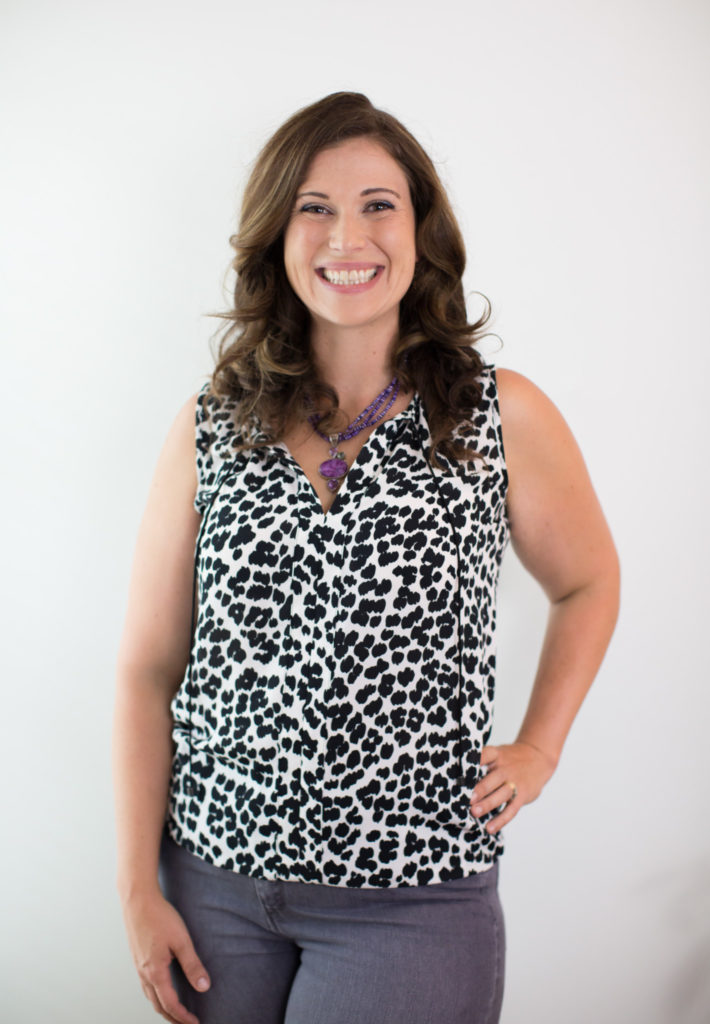 I “went Paleo” on August 31st, 2011, planning to one-up Robb Wolf’s “try it for 30 days” and commit to a full three months of this nutritional template. It wasn’t any more challenging than following low-carb diets had been in the past. But, Paleo did something that low-carb had never done: I saw dramatic improvements in disease symptoms.
I “went Paleo” on August 31st, 2011, planning to one-up Robb Wolf’s “try it for 30 days” and commit to a full three months of this nutritional template. It wasn’t any more challenging than following low-carb diets had been in the past. But, Paleo did something that low-carb had never done: I saw dramatic improvements in disease symptoms.
My symptoms of IBS and acid reflux disappeared. I stopped getting migraines. My mood and my ability to cope with life were profoundly improved. I was in less pain. My energy increased. I slept better. My asthma and allergies diminished. My acne and my eczema started to clear. My immune system seemed stronger and I no longer got every single cold my children brought into the house. Within two weeks of following the Paleo diet, I was able to stop taking all of my prescription medications, some of which I had been taking for 12 years. I also lost 20 more pounds in two months.
I became a zealot.
Not only had my experience made me a firm believer in the therapeutic potential of the right foods, but it completely changed my perspective on diet. No longer did I see foods as calories and carbohydrate grams, but now I started paying attention to micronutrients. I started thinking about nourishing my body rather than simply providing it with energy. And I saw food as something that could make me healthier instead of just something that could make me fat or thin, depending on my choices. And I started understanding the importance of lifestyle factors too.
And, best of all, I was discovering the scientific foundation for the Paleo template. This wasn’t some crazy fad that dissolved under scientific scrutiny. Nor even was it historical reenactment based on our understanding of the diets of Paleolithic man. The tenets of the Paleo diet and lifestyle are each supported by physiology, cell and molecular biology, and nutritional sciences. I was nerding out!
I couldn’t stop talking about Paleo, to my friends, to my family, to my husband, to my hair dresser, to my dental hygienist…. I needed an outlet for my enthusiasm, so a mere two months after adopting the Paleo diet, I had the idea to start a blog. It would be a place for me to share the recipe creations I was coming up with at home, a place to talk about the science supporting this way of life, a place to share my experiences, and a mechanism for helping others discover solutions to their health woes. Around the same time as I launched this website, I talked my husband into consenting to have the entire family transition to Paleo. While I jumped in with both feet, my husband and two daughters transitioned slowly over six months. It made a transformative difference in the health of each of my daughters; you can read more about their story here.
The popularity of my site skyrocketed quickly and within ten months, I was offered the opportunity to write my first book. Paleo became more than a way of life, it became my mission.
Over my first year of following the Paleo template, I continued to refine my approach. I adopted the Autoimmune Protocol in order to help resolve my lichen planus which did not improve with standard Paleo. I became a nutrient-seeker and discovered local farmers. Two years after adopting the Paleo diet, I took up CrossFit. Around the same time, I sought the expertise of a functional medicine specialist who was finally able to provide me with a Hashimoto’s thyroiditis diagnosis and has helped me continue to refine and troubleshoot as I face new health challenges relating to a burgeoning high-power career as an author, blogger, health expert, and public figure. I found my voice in providing approachable explanations of the science concepts behind the Paleo Diet in my books and website. I merged a longstanding passion for scientific literacy with one for improving public health. I found who I was meant to be.
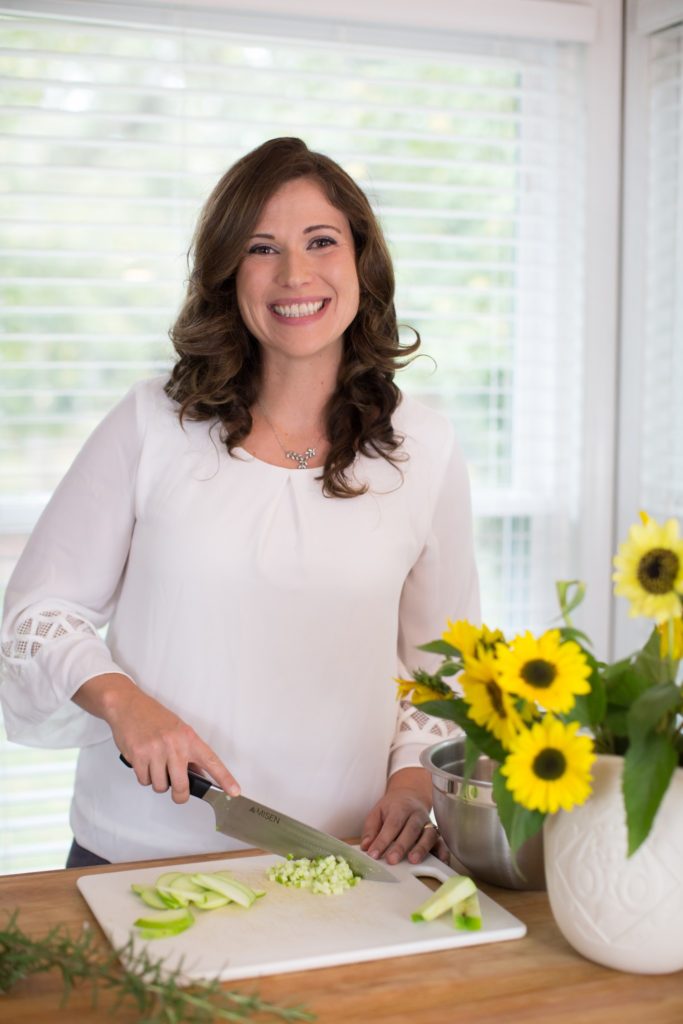 My metric for evaluating my health has changed. No longer do I look at the number on the scale or on my clothing tags as my sole method to evaluate my health. Now, I consider my energy levels, how well I sleep, my moods, how much I enjoy activity and how well I perform at the gym, how productive I am at work, how easily I laugh, how I feel when I hop out of bed in the morning, the quality of my skin and hair, and how I handle stressful events all as criteria. I look to food to provide the raw materials that every chemical reaction within every cell needs. I look at the roles that sleep, activity, and stress play in hormone, neurotransmitter and immune regulation. I consider the health of my gut microbiota and choose foods that best nourish them in addition to me.
My metric for evaluating my health has changed. No longer do I look at the number on the scale or on my clothing tags as my sole method to evaluate my health. Now, I consider my energy levels, how well I sleep, my moods, how much I enjoy activity and how well I perform at the gym, how productive I am at work, how easily I laugh, how I feel when I hop out of bed in the morning, the quality of my skin and hair, and how I handle stressful events all as criteria. I look to food to provide the raw materials that every chemical reaction within every cell needs. I look at the roles that sleep, activity, and stress play in hormone, neurotransmitter and immune regulation. I consider the health of my gut microbiota and choose foods that best nourish them in addition to me.
I used to joke that I would be dead at least 100 times if it weren’t for the miracles of modern medicine. But, as I reflect back on the health conditions I suffered, I now see the links between them. I clearly see the linear progression of one pathology. I see Hashimoto’s thyroiditis at the root of all of my health struggles, my gut getting progressively leakier, my body getting more and more inflamed, my hormones increasingly poorly regulated, and new autoantibodies forming leading to additional autoimmune diagnoses. Everything seems connected. And the Paleo template has been my solution.
I don’t regret growing up with chronic disease though. Feeling tired and lousy all the time forced me to develop an incredible work ethic and ambition that drives my current success. My experiences of being bullied, having low self-esteem, and with disordered eating provides compassion and context for the resources I create. And the juxtaposition between my health lows and highs motivates me to create the best educational resources for public health. My medical research background forms the foundation of how I approach the tenets of the Paleo template. My passion for science and scientific literacy suffuses everything I do. My enjoyment of cooking and food fuel a sustainable and balanced approach to this template. My love of my daughters and my deep appreciation of my family help me look forward, focusing on long term health and wellness. It is the sum of my experiences who have made me who I am and led me to become The Paleo Mom.
